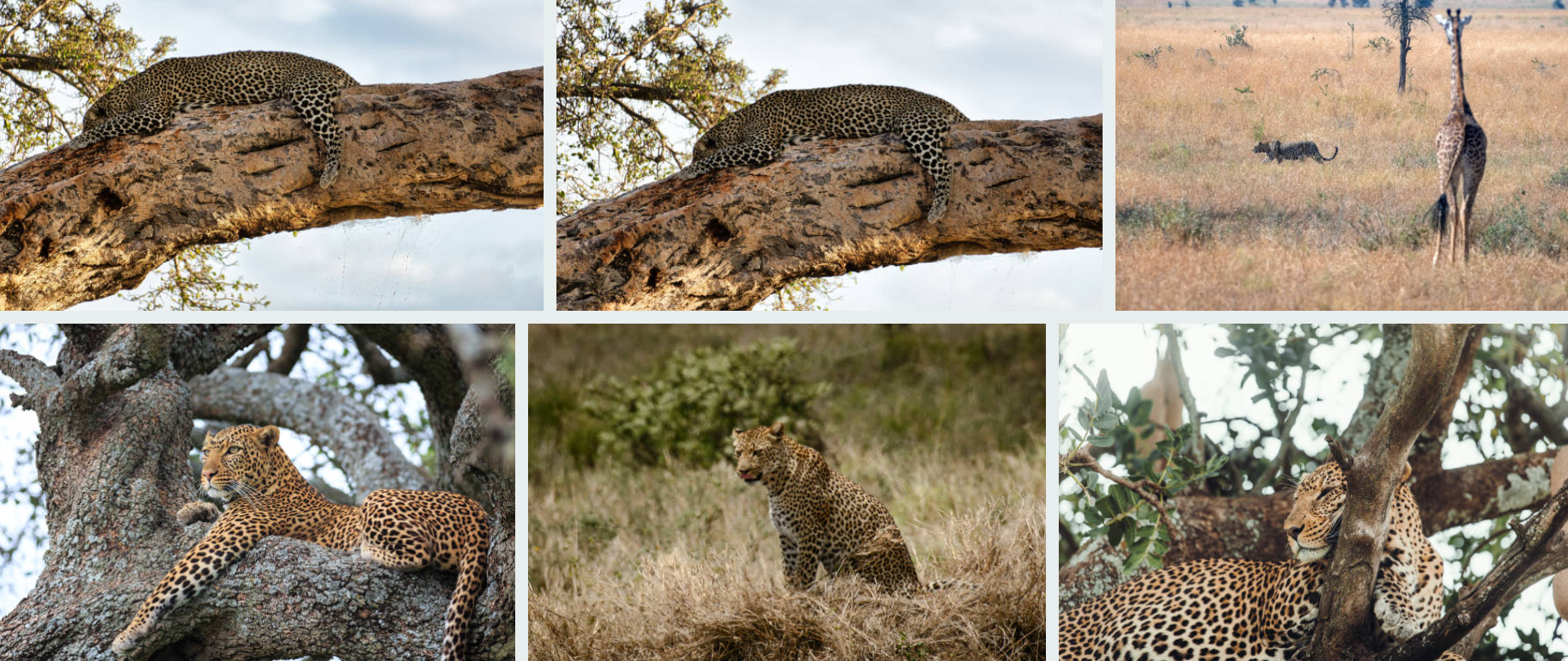What’s the Best Park for Leopard Sightings?
East Africa is known for its remarkable predator diversity, and among the most elusive and fascinating of these is the leopard. Coveted by wildlife enthusiasts, these cats combine unrivalled camouflage, stealthy hunting, and arboreal habits. But where in East Africa is your best bet to glimpse a leopard? While many parks offer leopards, one stands out above all. This guide explores East Africa’s leading leopard venues—explaining why, what to expect, how to plan, and why booking with Great Migration Adventure gives you the edge in experiencing these magnificent cats.

Why Leaping Leopards Captivate
Leopards are elegant, solitary, and secretive. Their solitary habits mean that even in areas with high densities, sightings can be rare. When you do see one hunting at dusk, dragging a kill into a tree, or lounging in shade, the experience is deeply rewarding. Leopards demonstrate adaptability from rugged highlands to dense forest. They embody survival, patience, and stealth. Many travelers say that spotting a leopard feels like entering another realm of the African bush.
Comparison of Top Parks
Masai Mara National Reserve
The Mara is famous for its predator abundance. While lions and cheetahs dominate attention, leopards are present in moderate numbers. Tree-climbing behaviour and daytime sightings are uncommon, and dense bush along riverine corridors provides cover. Leopard encounters here, though possible, are not guaranteed and depend on luck and guide skill.
Serengeti National Park
The Serengeti supports healthy leopard populations scattered across kopjes, woodlands, and river valleys. Sightings tend to occur early and late in the day, near hippo pools, acacia woodlands, and rocky boulders. Leopards sometimes take prey into trees near permanent waterholes, but viewing is often fleeting among wide open plains.
Ngorongoro Conservation Area
The crater rim and surrounding highlands are leopard habitat, but these predators are shy and inconspicuous. Vegetation patches and forest patches support them, yet visitor roads are limited, reducing exposure. Leopard sightings in Ngorongoro are possible—but not among the most reliable.
Lake Manyara National Park
Manyara is known for tree-climbing lions not leopards. Leopard numbers are low, and dense forest canopy is less visible from road. Encounters do happen but are rare.
Queen Elizabeth National Park
Uganda’s Queen Elizabeth NP has leopards in its Kasenyi plains and forested sectors near Kyambura Gorge. Sightings may occur along the Kasenyi track at dusk, or in the gorge where leopards hunt primates. While excellent biodiversity cinema, leopard viewing is unpredictable.
Ruaha National Park
Ruaha is home to one of Tanzania’s densest leopard populations. Thick miombo woodlands and granite outcrops are ideal leopard terrain. Game-drives can yield frequent leopard sightings due to smaller visitor numbers, longer routes, and remote terrain. Tracks and fresh scent marking often indicate leopard territory. Still, Ruaha remains lesser‑visited compared to the Mara or Serengeti.
Selous Game Reserve (Nyerere National Park)
Now officially Nyerere, Selous is remote and vast. Its leopard population is healthy but access via foot or boat-based exploration is limited. Sightings are possible, but often fleeting, given the scale.
Why the Top Park for Leopard Sightings Is…
On balance, Ruaha National Park emerges as the most reliable park in East Africa for leopard sightings. Its combination of high leopard density, varied habitat, few crowds, and long drive tracks gives leopard encounters a better chance than anywhere else in the region.
What Makes Ruaha Special for Leopards?
Ruaha’s geography—deep valleys, river systems, rocky kopjes, granite outcrops and miombo woodlands—creates rich leopard ecosystems. Leopards thrive in areas with prey availability and dense ambushing cover. Ruaha’s size and low tourism pressure mean that managers and guides often have space and time to follow leopard activity without hurried schedules. Frequent tracking of fresh leopard tracks, scent posts, and kills allows multiple sighting attempts. Guides are deeply familiar with individual leopards—watching females near dens or dusk activity on ridgelines. Where other parks can deliver occasional glimpses, Ruaha can deliver multiple sightings in a single trip.
When to Visit for Best Leopard Viewing
Dry seasons—typically June through October and January through February—are ideal. Water scarcity drives prey toward rivers, increasing predator concentration. Leopards often descend from hilltops to hunt in deeper valleys. Vegetation thinning improves visibility. Ruaha’s visibility between camps is excellent in these months, and remote location ensures minimal interference from other vehicles.
How Great Migration Adventure Enhances Leopard Safari
Great Migration Adventure’s approach amplifies your leopard sighting odds. We coordinate stays at least one night at a camp near known leopard activity, and we align your schedule around prime tracking hours. Our guides are local to Ruaha and network daily to locate known individuals, patrol tracks, and follow scent routes. We offer small groups to reduce disturbance and maximize viewing. Our custom itineraries include drive routes long enough to stay with a sighting rather than move on quickly. We provide amenities like photography hides, docile bush teas on koppie tops, and tracking briefings nightly.
What to Expect If You See a Leopard
Expect stillness. Leopards favor the early morning or dusk when prey moves. You may spot a silhouette lounging on granite slabs or tucked into branch shade. With patience and skilled guide interpretation, you learn to notice lingered shadows, remnants of a kill wrapped in branches, rustles in the grass. Some guests witness a leopard drag prey into a low tree; others spot their cubs peeking from scrub. These moments unfold quietly, best savoured from shaded vehicle windows. Our teams support respectful distance and ample observation time.
Sample 7‑Night Ruaha Leopard Safari Itinerary
Day 1: Arrive Dar es Salaam or Kilimanjaro, charter flight to Ruaha airstrip, drive to central camp, evening orientation.
Day-2: Morning and afternoon drives targeting leopard tracks around Ruaha River, sundowner on hilltop.
Day 3: Full-day route through southern hills—game tracking and midday hide near hippo pool where leopard activity is reported.
Day-4: Walking safari in miombo country, followed by late afternoon drive near granite outcrops where local female den has been monitored.
Day 5: Relocate camp to western part of park—habitat shift to acacia plains known for habitual leopard movement.
Day-6: Early dawn search, midday rest, evening drive along granitic ridge, spotlighting for nocturnal activity.
Day 7: Optional walking safari or photohide session—tracking recent leopard activity. Final sunset drive concludes the safari.
Day-8: Morning drive, transfer to airstrip, return flight and onward connections.
Other Locations Worth Leopard-Focused Visits
While Ruaha leads for reliability, other parks can enrich your leopard safari:
Serengeti—ideal for leopard sightings near permanent waterholes and kopje systems, especially during quieter months (April‑May or late November).
Mara—although sightings are sporadic, crowd-free conservancies on the Mara North or Mara Triangle may offer better leopard habitat experience.
Ngorongoro Highlands—combine crater floor drives with crater-edge walks near shaded forested hills.
Queen Elizabeth NP—pair Kasenyi game drive undisturbed by sunset with gorge walks in Kyambura, a known chimp and occasional leopard corridor.
Laikipia and Lewa Conservancy (Kenya)—private conservancies in Laikipia support leopard tracking on foot or vehicle along ridgelines, often with habituated individuals in communal grazing landscapes.
Practical Tips for Leopard Safari
Dress neutral, avoid bright colors. Patience is key—sightings may require hours of waiting quietly. Use binoculars and long‑lens photography setups. Avoid sudden movements or loud noise near observed cats. Observe at respectful distances. Sunscreen, water, shaded clothing, and hats are essential in daytime drives. Night drives are not permitted in Ruaha, as in many Tanzanian parks—although headlamp follow‑up is occasionally permitted near camp for sound tracking, always adhering to park rules.
Conservation Appeal and Responsible Travel
Leopards face threats from habitat fragmentation, retaliatory killings, and bushmeat hunting in certain regions. Ruaha plays a central role in protecting central Tanzanian leopard populations. By choosing a safari with Great Migration Adventure in Ruaha, you contribute to conservation funding, anti-poaching patrols, and community outreach. We partner with camps and lodges that hire local guides, support village projects, and maintain low-impact camp protocols.
Frequently Asked Questions
Can leopards be seen by night? Night drives within Ruaha park are prohibited, but early morning and dusk visibility is typically sufficient. Occasionally, after‑dark drive follow‑ups to locate a calling leopard are permitted near camp under strict rules.
Is leopard viewing guaranteed? No wildlife sighting is guaranteed. But Ruaha offers the most frequent leopard encounters in the region.
Can families with kids see leopards safely? Yes—safaris are tailored for families with safe viewing distances, educational commentary, and flexible pacing.
Winters (June–October) are best for sightings. Wet months bring lush but dense vegetation, making spotting harder but results in richer bird and leopard prey base.
Guest Stories
One guest saw a female leopard emerge at sunset from riverine bush, glide onto a rock ledge, scan plains before sleeping. Another spent half an hour witnessing a pair of siblings dragging prey into a low tree, silhouetted by golden hour light. Rwanda visitors on different safaris were surprised by Ruaha’s solitude yet rewarded with repeated leopard glances when others reported none.
Conclusion: Why Ruaha is the Leopard Capital of East Africa
While leopards roam many East African parks, Ruaha offers a unique combination: high densities, ideal terrain, few crowds, and long‑track opportunities—augmented by Great Migration Adventure’s local knowledge, tailor‑made planning, and commitment to wildlife stewardship.
If you’re searching for the best place to see leopards in East Africa, Ruaha deserves serious attention. With Great Migration Adventure, you’ll enjoy expert guidework, ethical practices, flexible itineraries, and multiple opportunities to connect with one of nature’s most captivating cats.









